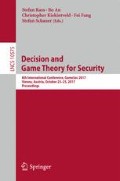Abstract
We propose a Stackelberg game model for Moving Target Defense (MTD) where the defender periodically switches the state of a security sensitive resource to make it difficult for the attacker to identify the real configurations of the resource. Our model can incorporate various information structures. In this work, we focus on the worst-case scenario from the defender’s perspective where the attacker can observe the previous configurations used by the defender. This is a reasonable assumption especially when the attacker is sophisticated and persistent. By formulating the defender’s problem as a Markov Decision Process (MDP), we prove that the optimal switching strategy has a simple structure and derive an efficient value iteration algorithm to solve the MDP. We further study the case where the set of feasible switches can be modeled as a regular graph, where we solve the optimal strategy in an explicit way and derive various insights about how the node degree, graph size, and switching cost affect the MTD strategy. These observations are further verified on random graphs empirically.
Access this chapter
Tax calculation will be finalised at checkout
Purchases are for personal use only
References
Tankard, C.: Advanced persistent threats and how to monitor and deter them. Netw. Secur. 2011(8), 16–19 (2011)
Jajodia, S., Ghosh, A.K., Swarup, V., Wang, C., Wang, X.S.: Moving Target Defense: Creating Asymmetric Uncertainty for Cyber Threats, vol. 54. Springer, New York (2011). doi:10.1007/978-1-4614-0977-9
Jafarian, J.H., Al-Shaer, E., Duan, Q.: Openflow random host mutation: transparent moving target defense using software defined networking. In: Proceedings of the First Workshop on Hot topics in Software Defined Networks, pp. 127–132 (2012)
Salamat, B., Jackson, T., Wagner, G., Wimmer, C., Franz, M.: Runtime defense against code injection attacks using replicated execution. IEEE Trans. Depend. Secur. Comput. 8(4), 588–601 (2011)
Nguyen-Tuong, A., Evans, D., Knight, J.C., Cox, B., Davidson, J.W.: Security through redundant data diversity. In: IEEE International Conference on Dependable Systems and Networks, pp. 187–196 (2008)
Zhu, Q., Başar, T.: Game-theoretic approach to feedback-driven multi-stage moving target defense. In: Das, S.K., Nita-Rotaru, C., Kantarcioglu, M. (eds.) GameSec 2013. LNCS, vol. 8252, pp. 246–263. Springer, Cham (2013). doi:10.1007/978-3-319-02786-9_15
Carter, K.M., Riordan, J.F., Okhravi, H.: A game theoretic approach to strategy determination for dynamic platform defenses. In: Proceedings of the First ACM Workshop on Moving Target Defense, pp. 21–30 (2014)
Sengupta, S., Vadlamudi, S.G., Kambhampati, S., Doupé, A., Zhao, Z., Taguinod, M., Ahn, G.-J.: A game theoretic approach to strategy generation for moving target defense in web applications. In: International Conference on Autonomous Agents and MultiAgent Systems (AAMAS), pp. 178–186 (2017)
Nochenson, A., Heimann, C.F.L.: Simulation and game-theoretic analysis of an attacker-defender game. In: Grossklags, J., Walrand, J. (eds.) GameSec 2012. LNCS, vol. 7638, pp. 138–151. Springer, Heidelberg (2012). doi:10.1007/978-3-642-34266-0_8
Lisỳ, V., Davis, T., Bowling, M.H.: Counterfactual regret minimization in sequential security games. In: Association for the Advancement of Artificial Intelligence (AAAI), pp. 544–550 (2016)
Yin, Z., Korzhyk, D., Kiekintveld, C., Conitzer, V., Tambe, M.: Stackelberg vs. nash in security games: interchangeability, equivalence, and uniqueness. In: International Conference on Autonomous Agents and Multiagent Systems (AAMAS), pp. 1139–1146 (2010)
Feng, X., Zheng, Z., Mohapatra, P., Cansever, D., Swami, A.: A signaling game model for moving target defense. In: IEEE Conference on Computer Communications (INFOCOM) (2017)
Zhuang, R., DeLoach, S.A., Ou, X.: A model for analyzing the effect of moving target defenses on enterprise networks. In: Proceedings of the 9th Annual Cyber and Information Security Research Conference, pp. 73–76 (2014)
Maleki, H., Valizadeh, S., Koch, W., Bestavros, A., van Dijk, M.: Markov modeling of moving target defense games. In: ACM Workshop on Moving Target Defense, pp. 81–92 (2016)
Erdős, P., Rényi, A.: On the evolution of random graphs. Publ. Math. Inst. Hung. Acad. Sci. 5(1), 17–60 (1960)
Puterman, M.L.: Markov Decision Processes: Discrete Stochastic Dynamic Programming. Wiley, New York (2014)
Acknowledgement
The effort described in this article was partially sponsored by the U.S. Army Research Laboratory Cyber Security Collaborative Research Alliance under Contract Number W911NF-13-2-0045. The views and conclusions contained in this document are those of the authors, and should not be interpreted as representing the official policies, either expressed or implied, of the Army Research Laboratory or the U.S. Government. The U.S. Government is authorized to reproduce and distribute reprints for Government purposes, notwithstanding any copyright notation hereon. This research was also supported in part by a grant from the Board of Regents of the State of Louisiana LEQSF(2017-19)-RD-A-15.
Author information
Authors and Affiliations
Corresponding author
Editor information
Editors and Affiliations
Rights and permissions
Copyright information
© 2017 Springer International Publishing AG
About this paper
Cite this paper
Feng, X., Zheng, Z., Mohapatra, P., Cansever, D. (2017). A Stackelberg Game and Markov Modeling of Moving Target Defense. In: Rass, S., An, B., Kiekintveld, C., Fang, F., Schauer, S. (eds) Decision and Game Theory for Security. GameSec 2017. Lecture Notes in Computer Science(), vol 10575. Springer, Cham. https://doi.org/10.1007/978-3-319-68711-7_17
Download citation
DOI: https://doi.org/10.1007/978-3-319-68711-7_17
Published:
Publisher Name: Springer, Cham
Print ISBN: 978-3-319-68710-0
Online ISBN: 978-3-319-68711-7
eBook Packages: Computer ScienceComputer Science (R0)

